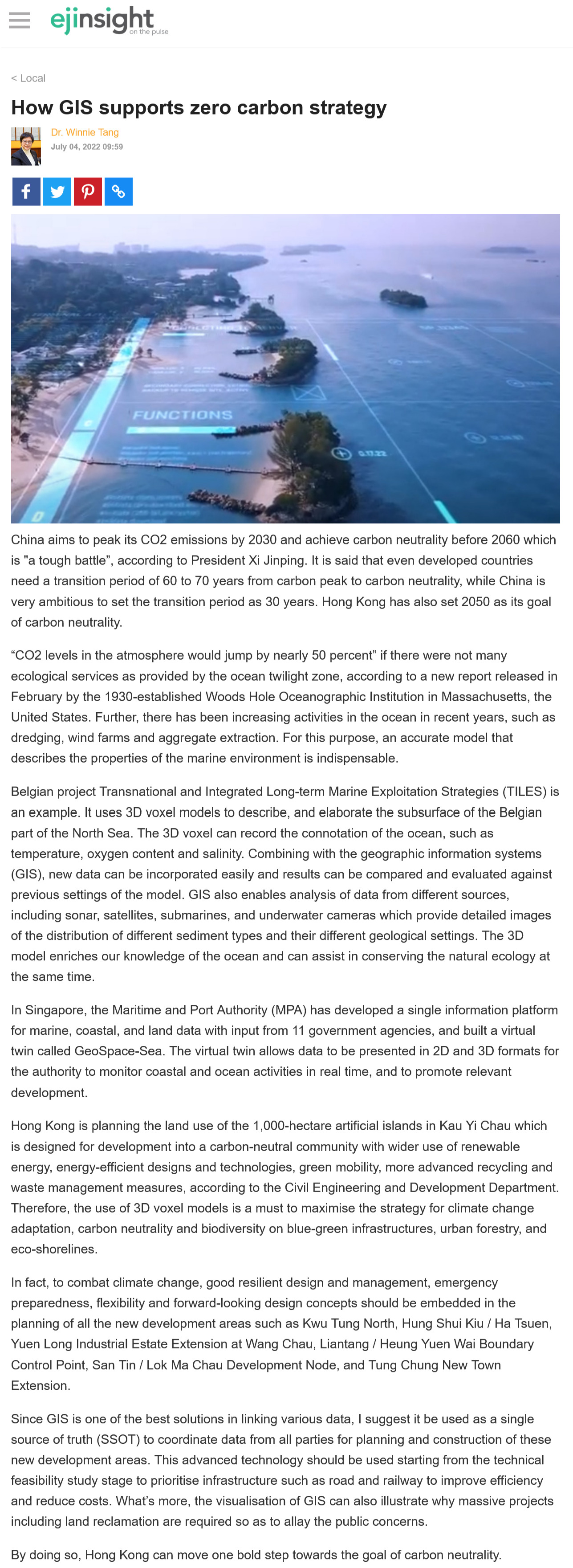網上版請按此

How GIS supports zero carbon strategy
China aims to peak its CO2 emissions by 2030 and achieve carbon neutrality before 2060 which is "a tough battle", according to President Xi Jinping. It is said that even developed countries need a transition period of 60 to 70 years from carbon peak to carbon neutrality, while China is very ambitious to set the transition period as 30 years. Hong Kong has also set 2050 as its goal of carbon neutrality.
"CO2 levels in the atmosphere would jump by nearly 50 percent" if there were not many ecological services as provided by the ocean twilight zone, according to a new report released in February by the 1930-established Woods Hole Oceanographic Institution in Massachusetts, the United States. Further, there has been increasing activities in the ocean in recent years, such as dredging, wind farms and aggregate extraction. For this purpose, an accurate model that describes the properties of the marine environment is indispensable.
Belgian project Transnational and Integrated Long-term Marine Exploitation Strategies (TILES) is an example. It uses 3D voxel models to describe, and elaborate the subsurface of the Belgian part of the North Sea. The 3D voxel can record the connotation of the ocean, such as temperature, oxygen content and salinity. Combining with the geographic information systems (GIS), new data can be incorporated easily and results can be compared and evaluated against previous settings of the model. GIS also enables analysis of data from different sources, including sonar, satellites, submarines, and underwater cameras which provide detailed images of the distribution of different sediment types and their different geological settings. The 3D model enriches our knowledge of the ocean and can assist in conserving the natural ecology at the same time.
In Singapore, the Maritime and Port Authority (MPA) has developed a single information platform for marine, coastal, and land data with input from 11 government agencies, and built a virtual twin called GeoSpace-Sea. The virtual twin allows data to be presented in 2D and 3D formats for the authority to monitor coastal and ocean activities in real time, and to promote relevant development.
Hong Kong is planning the land use of the 1,000-hectare artificial islands in Kau Yi Chau which is designed for development into a carbon-neutral community with wider use of renewable energy, energy-efficient designs and technologies, green mobility, more advanced recycling and waste management measures, according to the Civil Engineering and Development Department. Therefore, the use of 3D voxel models is a must to maximise the strategy for climate change adaptation, carbon neutrality and biodiversity on blue-green infrastructures, urban forestry, and eco-shorelines.
In fact, to combat climate change, good resilient design and management, emergency preparedness, flexibility and forward-looking design concepts should be embedded in the planning of all the new development areas such as Kwu Tung North, Hung Shui Kiu / Ha Tsuen, Yuen Long Industrial Estate Extension at Wang Chau, Liantang / Heung Yuen Wai Boundary Control Point, San Tin / Lok Ma Chau Development Node, and Tung Chung New Town Extension.
Since GIS is one of the best solutions in linking various data, I suggest it be used as a single source of truth (SSOT) to coordinate data from all parties for planning and construction of these new development areas. This advanced technology should be used starting from the technical feasibility study stage to prioritise infrastructure such as road and railway to improve efficiency and reduce costs. What's more, the visualisation of GIS can also illustrate why massive projects including land reclamation are required so as to allay the public concerns.
By doing so, Hong Kong can move one bold step towards the goal of carbon neutrality.
Dr. Winnie Tang
Adjunct Professor, Department of Computer Science, Faculty of Engineering; Department of Geography, Faculty of Social Sciences; and Faculty of Architecture, The University of Hong Kong